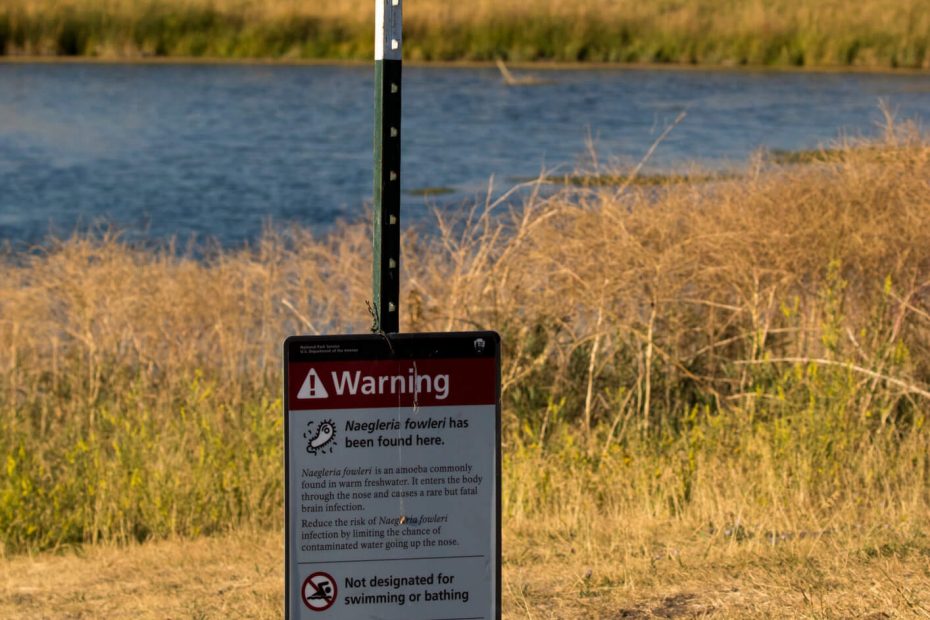During each summer, a multitude of warnings are issued across the United States regarding the hazards of swimming in pools and lakes in warm states such as Florida, the Carolinas and California. More recently, warnings have even been issued for states farther north, such as Ohio [1, 2]. The warnings are related to the presence of the “brain-eating amoeba”: Naegleria fowleri.
This amoeba causes primary amoebic meningoencephalitis (PAM), a rare yet severe brain infection. PAM’s mortality rate is extraordinarily high, often exceeding 97% [3]. The free-living amoeba is found in warm freshwater environments such as lakes, hot springs and poorly maintained swimming pools. The amoeba’s presence in bodies of water is facilitated by its resistance to chlorine disinfection at lower concentrations — a common issue in inadequately treated recreational water systems [3]. It is notorious for its ability to invade the central nervous system, leading to a rapidly developing and fatal condition. Understanding the environmental factors, pathology and current treatment options is crucial to improve public health responses and outcomes related to Naegleria fowleri infections.
The amoeba exists primarily in three forms: cyst, trophozoite and flagellate. In its cyst form, N. fowleri can endure harsh environmental conditions such as extreme temperatures and desiccation. Under favorable conditions, such as warm water with ample nutrients, the cyst transforms into the active trophozoite form responsible for infection [4, 5]. However, despite its presence in the environment, infections are rare because the amoeba must enter the human body through the nasal passages to cause disease [6].
The pathogenicity of Naegleria fowleri is primarily attributed to its ability to invade the brain. Infection begins when water containing the trophozoites is forced up the nasal cavity, which has been reported from people swimming and people performing nasal irrigation and ritual nasal ablution using tap water [3]. From the nasal passages, the amoeba travels along the olfactory nerve to the brain, where it causes severe inflammation and necrosis [6].
Diagnosing PAM is challenging because its clinical manifestations resemble those of bacterial meningitis. As the disease progresses, symptoms such as altered mental status, seizures and coma may develop rapidly. Histopathological examination reveals widespread destruction of brain tissue, characterized by necrosis and hemorrhage [4, 7]. The disease’s aggressive nature is exacerbated by the amoeba’s ability to rapidly invade and destroy brain tissue, leading to a swift and often fatal progression.
Treatment options for Naegleria fowleri infections are limited and primarily experimental [6]. Recently, a successfully treated case of PAM was published in the journal Emerging Infectious Diseases. The patient was thought to have become infected by nasal irrigation using tap water, and the treatment was an invasive and prolonged course of antibiotics as the patient deteriorated into a coma [7]. Fortunately, the patient recovered, making him part of the lucky 2% of cases that defeat this amoeba. Early diagnosis and prompt treatment are critical for survival, and the current treatment regimen includes a combination of antifungal and antimicrobial agents. Miltefosine is the primary drug used [8]. Other drugs employed include amphotericin B (an antifungal) and a combination of rifampin and azithromycin [6, 7].
While the prognosis remains poor, research into more effective therapies and better diagnostic tools is ongoing to improve outcomes for affected individuals.
N. fowleri is being found farther north in the hemisphere than before, even reaching latitudes beyond Baltimore [2]. This could lead to an increase in human exposure to the trophozoite form of the amoeba. It is important to address a possible rise in the number of PAM cases and the challenges regarding detection and treatment of the disease as climate change continues to alter ecosystems globally.
References:
- Gharpure, R., Gleason, M., Salah, Z., Blackstock, A.J., Hess-Homeier, D., Yoder, J. S., Cope, J.R. (2021). Geographic Range of Recreational Water-Associated Primary Amebic Meningoencephalitis, United States, 1978–2018. Emerging Infectious Diseases, 27(1), 271– doi.org/10.3201/eid2701.202119
- Towne, K., Polivka, (2023). Primary Amoebic Meningoencephalitis and the Naegleria fowleri Freshwater Amoeba: A New Concern for Northern Climates. Ohio Journal of Public Health, 5(2). doi.org/10.18061/ojph.v5i2.9240
- Gharpure, R., Bliton, J., Goodman, A., Ali, I.K.M., Yoder, J. Cope, J.R. (2021). Epidemiology and Clinical Characteristics of Primary Amebic Meningoencephalitis Caused by Naegleria fowleri: A Global Review. Clinical Infectious Diseases, 73(1), e19–e27. org/10.1093/cid/ciaa520
- Visvesvara, G.S., Moura, H., Schuster, F.L. (2007). Pathogenic and Opportunistic Free-living Amoebae: Acanthamoeba Spp., Balamuthia Mandrillaris, Naegleria Fowleri and Sappinia Diploidea. FEMS Immunology & Medical Microbiology, 50(1), 1–26. org/10.1111/j.1574-695X.2007.00232.x
- Schuster, F.L. Visvesvara, G.S. (2004). Free-living Amoebae as Opportunistic and Non-opportunistic Pathogens of Humans and Animals. International Journal for Parasitology, 34(9), 1001–1027. org/10.1016/j.ijpara.2004.06.004
- Grace, E., Asbill, S., Virga, K. (2015). Naegleria fowleri: Pathogenesis, Diagnosis, and Treatment Options. Antimicrobial Agents Chemotherapy, 59. org/10.1128/aac.01293-15
- Burki, A., Satti, L., Mahboob, S., Anwar, S., Bizanjo, M., Rafique, M., Ghanchi, N. (2024). Successful Treatment of Confirmed Naegleria fowleri Primary Amebic Meningoencephalitis. Emerging Infectious Diseases, 30(4), 803–805. org/10.3201/eid3004.230979
- Alli, A., Ortiz, J.F., Morillo Cox, Á., Armas, M., Orellana, V.A. (2021). Miltefosine: A Miracle Drug for Meningoencephalitis Caused by Free-Living Amoebas. Cureus, 13(3), e13698. org/10.7759/cureus.13698
Related Content
- What’s in a Brain?
- What Birds in Love Teach Us About How the Brain Processes Competing Motivations
- This is your brain… This is your brain on NIBS
Want to read more from the Johns Hopkins School of Medicine? Subscribe to the Biomedical Odyssey blog and receive new posts directly in your inbox.
